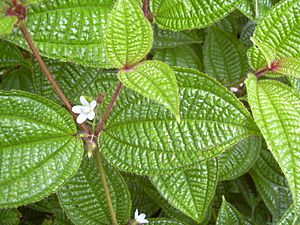Soapbush facts for kids
Quick facts for kids Soapbush |
|
|---|---|
 |
|
| Scientific classification | |
| Genus: |
Miconia
|
| Species: |
crenata
|
| Synonyms | |
|
|
Miconia crenata, also known as soapbush, clidemia, or Koster's curse, is a plant that lives for many years. It is a type of shrub that grows thickly. This plant is considered an invasive plant in many warm parts of the world. It causes serious harm to local plants and environments.
Contents
What Does Miconia crenata Look Like?
Miconia crenata is a bushy plant that usually grows between 0.5 and 3 meters (about 1.5 to 10 feet) tall. Sometimes, it can even reach 5 meters (16 feet) in height. Its branches are covered with stiff, brown or reddish hairs.
The leaves grow in pairs on opposite sides of the stem. They are oval-shaped with a wide base and pointed tips. Their edges can be almost smooth or have small teeth. The leaves have a few hairs on top and more hairs underneath. They also have five clear veins that run from the base to the tip.
The flowers grow in small groups at the ends of the branches. Each flower has five white or light pink petals. It also has five unique stamens that look like claws. The bottom part of the flower is swollen and cup-shaped. It has some bristly and sticky hairs.
The plant produces small, round fruits that are berries. These berries are dark blue, purple, or black. Each berry holds more than 100 tiny, light brown seeds.
Where Does Miconia crenata Grow?
This plant is originally from warm areas in the Americas. This includes places from Mexico all the way to Paraguay, and also the Caribbean islands. It can grow in both dry and wet tropical climates, up to about 1,200 meters (4,000 feet) above sea level.
Other Names for the Plant
One common name for Miconia crenata is "Koster's curse." This name is used in places like Hawaii where the plant is a harmful weed. It was brought to Fiji in the late 1800s. A coffee farmer likely shared its seeds. People in the area mistakenly thought a sugar farmer named Köster was responsible for bringing it. Other common names for this plant are soapbush and clidemia.
Why Miconia crenata Is a Problem Plant
Miconia crenata is native to tropical America. However, it has become an invasive species in parts of Southern Asia, East Africa, and some islands like Hawaii and Australia. An invasive species is a plant or animal that is not native to an area and causes harm to the environment.
This plant can grow in many places, such as wet pastures, open grasslands, farms, roadsides, and forests. It can form very thick patches that cover and choke out other plants, including native ones. When the ground is disturbed, like by wildfires, landslides, strong winds, or even pigs digging, it helps Miconia crenata grow and spread even faster.
In its native home, this plant usually grows only in open areas. It becomes dominant about a year after the land is disturbed, for example, after land is cleared for farming. In Hawaii, new areas of Miconia crenata always start along trails or other disturbed spots. It is replacing the native plants in Hawaii's forests, putting them at risk. It is also a major problem in places like the Comoros Archipelago, La Réunion, the Seychelles, and Mauritius. In Sri Lanka, it invades gaps in forests, stopping native plants from growing.
How to Control Miconia crenata
To keep this plant out of an area, the best way is to prevent the ground from being disturbed. This means avoiding things like wildfires and excessive digging.
One way to control it is by pulling the plants out of the ground by hand. Sometimes, special plant-killing chemicals called herbicides are also used. This can help, but it is often a temporary solution.
Scientists also use a method called biological control. This involves using natural enemies of the plant to control its growth. For Miconia crenata, a tiny insect called a thrips (Liothrips urichi) from Trinidad is used. This thrips is very good at controlling the plant in pastures. However, it is not as effective in forests. It was first used in Fiji in 1930.
Controlling wild pig populations is also important. Pigs dig up the ground, which helps Miconia crenata and other invasive plants spread. Sheep, however, do not eat Miconia crenata, so they are not helpful for control.
Some studies have shown that certain chemicals like triclopyr can kill Miconia crenata. Also, a special type of fungus called Colletotrichum gloeosporioides f.sp. clidemiae has been found to be effective against it.
Rules and Laws About Miconia crenata
The IUCN Invasive Species Specialist Group has named Miconia crenata as one of the "World's Worst" invasive plants. It is listed as a harmful weed in Queensland and the Northern Territories in Australia, and also in Hawaii. However, it is not listed as a harmful weed in Kenya, Tanzania, or Uganda.
Where It's Found in Australia
In 2001, a large group of Miconia crenata plants was found in Julatten, near Mount Molloy, Queensland. This outbreak could spread into the nearby Mount Lewis National Park and Mowbray National Park. Local groups are working together to control the plant in Julatten.
In New South Wales, Australia, there is a special phone number for people to call. They can report any sightings of the plant to the Department of Primary Industries.
Images for kids
See also
 In Spanish: Clidemia hirta para niños
In Spanish: Clidemia hirta para niños






